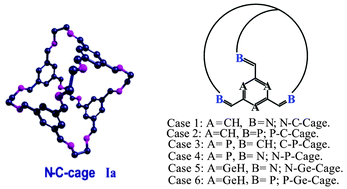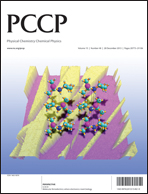Exploring the effectiveness of different Lewis pair combinations in caged structures for the catalysis of ammonia borane dehydrogenation: a DFT study†
Abstract
Zero dimensional cage structures containing four phenyl rings separated by imine linkers have recently been synthesized. In the current work, through a computational investigation using density functional theory (DFT), we demonstrate that modifying such cages by replacing the 2, 4, 6 carbon atoms in the phenyl rings to yield new rings, as well as replacing the imine moiety in the linker by other electronegative atoms, can yield interesting new cages that can be reactive in catalysing reactions such as the dehydrogenation of ammonia borane – an important reaction in hydrogen storage research. Specifically, it is predicted that phosphorus–nitrogen pairs (phosphorus in the 2, 4, 6 positions in the ring, nitrogen in the linker position), germanium–nitrogen and germanium–phosphorus pair combinations would lead to effective Lewis pairs that can work in tandem to dehydrogenate ammonia borane efficiently under room temperature conditions.


 Please wait while we load your content...
Please wait while we load your content...